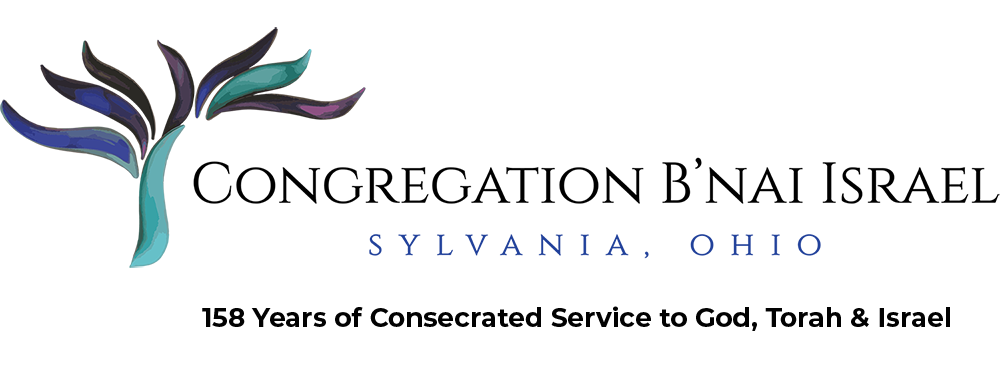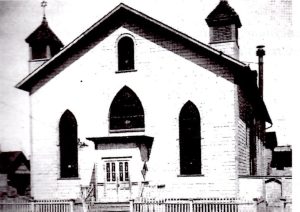
Woodruff and 12th Streets, 1888
There is evidence of Jewish people living in Toledo, Ohio, as early as 1837. Additionally, there are indications of a High Holiday Service held in Toledo in 1863, which may have been organized by the founders of B’nai Israel. The first reference to a formal congregation, however, was in 1866 at “Clarks Hall” on Cherry Street. Records are inconsistent, but 1866 appears to be the founding of what became Congregation B’nai Israel. At its inception, the congregation followed Orthodox tradition. A 1943 notice of the 77th Annual Meeting of the congregation indicates that 1866 was the founding year. Additionally, the congregation celebrated its centennial in 1966.
During the following two decades, B’nai Israel slowly moved westward in the downtown area occupying various venues, including buildings and homes on Madison, Lynn, Union, State and Allen Streets. A cornerstone for a permanent frame structure on Union and Woodruff, which is now located at Congregation B’nai Israel, identified the synagogue as “Beny Israel,” and was laid in 1888.
In its formative period, the congregation did not employ a full time rabbi. Instead, several lay leaders including an owner of a second hand clothing store and a kosher meat market employee served in several capacities as “pastor,” “reverend”, “cantor”, “assistant rabbi” and “rabbi.” Some of them held joint positions in other synagogues in the city. Several may have had rabbinic training. Only a few spoke English fluently.
The earliest congregants were Dutch and Polish Jews, most of whom were tradesmen and merchants. With the influx of east European immigrants to Toledo in the late nineteenth century, the congregation grew significantly. By 1908, membership had increased from its original founding seventeen families to 140. Nevertheless, it continued to share rabbis with other Orthodox congregations as well as with a short-lived synagogue that identified itself as “Conservative.”
In addition to the sanctuary, other institutions in the building catered to the growing Toledo Jewish community in the late nineteenth and early twentieth centuries. Talmud Torah classes were held early on and a Sunday School soon followed. B’nai Israel was also home to the communal Chevra Kadisha which was founded in 1867. In 1891, Eagle Point Cemetery was founded in Rossford on the east side of the Maumee River. By 1892, B’nai Israel had purchased a portion of the cemetery known as Beth Shalom on Otter Creek Road in Oregon, which was also on the east side of the Maumee. Prior to purchasing the land for the Jewish cemeteries, Jewish burials were held at Forest Cemetery located on Mulberry & Stickney Streets, east of Cherry Street.
In 1913, anticipating even more growth, B’nai Israel authorized the construction of a permanent brick structure. Located prominently on the corner of 12th Street and Bancroft and occupying a half block of the downtown area, the new synagogue had a massive inner dome and provided seating for 700 people on the main floor and 300 in the gallery. Built in the Arts and Crafts style, which emphasized simplicity of form, it was a departure from the opulence of earlier sacred architecture and reflected modern design elements. The groundbreaking was officiated by Rabbi Isaac M. Silverman, a graduate of the Jewish Theological Seminary who would maintain an ongoing relationship with the synagogue through 1918.
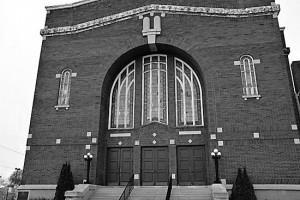
Bancroft and 12th Streets with Annex
In 1915, B’nai Israel took a step towards professionalizing the clergy by hiring a full-time rabbi, Louis Epstein, who was also ordained from the Jewish Theological Seminary. Epstein’s departure in 1918 was followed by a short period in which the congregation again shared its religious leadership with other synagogues. In 1922, another JTS graduate, Rabbi Michael Lichtenstein assumed the pulpit. At his urging, the congregation built a three-story annex in 1924 adjacent to the synagogue on 12th Street to serve as an educational and community center. It was a sign of the congregation’s growing membership (it had reached 250 by 1920 and continued to increase in the years following), that in 1927, Julius Ulman was hired as its first professionally trained cantor. Ulman would serve B’nai Israel for over forty years, retiring in 1968.
Until his untimely death in 1936, Rabbi Lichtenstein focused much of his attention on expanding Jewish education. Under his tenure, B’nai Israel hired a director of the Religious School, opened up the Sunday School to girls, helped to establish Sisterhood (then known as the Ladies Auxiliary) and the Men’s Club, and introduced the Confirmation ceremony. Lichtenstein also enlarged the role of B’nai Israel in the community by serving as president of the local B’nai Brith, participating in the Hebrew Cultural Organization, and serving in various capacities in the local branch of the Zionist Organization of America. The 12th Street building was placed on the National Register of Historic Places in 2005.
In 1937 shortly after Rabbi Lichtenstein’s death, Dr. Morton Goldberg assumed the pulpit. Over the next decade and a half, Dr. Goldberg transformed B’nai Israel from its Orthodox beginnings to Conservative Judaism. Included in the changes were a uniform prayer book, the use of English in services, the wearing of kippot for men (in place of top hats), late Friday night services, a community Passover Seder, and joint seating of men and women. During Dr. Goldberg’s tenure, Cantor Ulman created a choir. In 1944, B’nai Israel celebrated its first Shabbat morning bar mitzvah, when the cantor’s son was called up to the Torah. Eight years later, it held its first bat mitzvah, that of the rabbi’s daughter.
Dr. Goldberg’s sermons were noteworthy for their use of both Jewish and non-Jewish sources and their sensitivity to current social, political, and economic issues. During the 1940s, he introduced war relief programs at the synagogue, helped welcome Holocaust survivors to Toledo and sponsored a salute to the new State of Israel. Dr. Goldberg expanded the public face of the synagogue in the Toledo community by serving in various capacities on labor-management, community relations, public school, and mental health boards. Of particular significance was his involvement in improving race relations and interfaith understanding in Toledo. Dr. Goldberg also taught courses on Judaism and Jewish thought at several local colleges.
In 1948, B’nai Israel hired Nachman Berkowitz a Holocaust survivor from Poland, as its Ritual Director. For 36 years, “Reverend” Berkowitz, as he was known, served as torah reader, Hebrew School teacher, and daily minyan leader, and trained bar and bat mitzvah students. He retired from B’nai Israel in 1984 after thirty-six years of devoted service and continued his teaching at a synagogue in Tucson, Arizona.
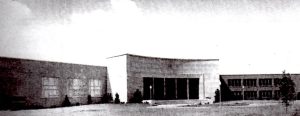
Kenwood Blvd.
By the 1950s, the congregation had increased its membership to over a thousand, making it the largest synagogue in Toledo and a major force in the Conservative movement in the United States.
Plans to construct a new building began as early as 1941, but were delayed by World War II and its immediate aftermath. The annex was no longer large enough to hold all of the religious school students, so a building on Collingwood Avenue was utilized for several years for overflow. After a concerted effort to raise funds, B’nai Israel was ready to look to the future.
Ground was broken for a new synagogue in 1954. The cornerstone was laid in 1955 and a formal dedication was held in January 1957. The new structure represented a dramatic turning point in B’nai Israel’s visibility and stature. Built on Kenwood Boulevard on a property formerly owned by Owens-Illinois near the University of Toledo and Toledo Hospital, the building followed the westward movement of Toledo Jewry from ‘downtown’ to the “suburbs.” The congregation originally donated part of the land to the Ursuline nuns for a school, but the Order chose to build elsewhere. The new building reflected mid-century modern architecture with massive front doors facing a major thoroughfare, a spacious lawn surrounding a circular driveway and ample parking space for hundreds of cars. Inside was a sanctuary seating 800 (which could be expanded to a 1200) with huge windows, a decorated wooden ark, and a choir loft. The synagogue also included a huge kitchen, a large social hall with a working stage, a chapel, a library and second-floor classrooms for a religious school. A gift shop was enlarged when the building underwent extensive remodeling in the 1980’s.
In 1968, Cantor Ullman retired after 41 years of service, and was replaced by Robert Shapiro. A year later, B’nai Israel hired Fishel Pearlmutter as Associate Rabbi.
In 1972, Rabbi Pearlmutter became co-rabbi with Dr. Goldberg. Later that year, after Dr. Goldberg’s retirement and his election as Rabbi Emeritus, Rabbi Pearlmutter assumed the role of Senior Rabbi.
In his first years at B’nai Israel, Rabbi Pearlmutter devoted himself to strengthening Conservative Judaism’s commitment to egalitarianism. With the assistance of Cantor Shapiro and Cantor Israel Barzak, who was appointed in 1979, he began counting women in the minyan, calling them up to the Torah for aliyot and including them in adult b’nai mitzvah classes. In 1979, Rabbi Pearlmutter officiated at the first adult bat mitzvah for twelve women. On the national level, he spearheaded the effort to have women join the Rabbinical Assembly and to ordain women rabbis.
In an effort to make the synagogue more welcoming and more relevant to contemporary concerns, Rabbi Pearlmutter held outdoor services on the patio and introduced havurot, in which small groups of families would come together in their homes to study and to celebrate Shabbat and holidays. Another major project that he introduced to B’nai Israel was Jewish Marriage Encounter. The rabbi and his wife Frances helped to organize retreats for couples, whose goal was to enhance their marriage and to increase their participation in ritual at home and in the synagogue. Over the years, Congregation B’nai Israel retained the services of rabbis in primarily non-pulpit positions. Rabbi Arthur Gould served as Assistant Rabbi from 1978-1980 with an emphasis on Youth and Education programming.
After thirteen years of service, Rabbi Pearlmutter retired because of ill health. Although Rabbi Pearlmutter participated in synagogue life until his death in 1983, B’nai Israel decided to hire a new rabbi, Herbert Yoskowitz, in 1982. He was succeeded by Arnold Bienstock in 1984. Rabbi Bienstock introduced the Interfaith Blood Drive to the community and was active in community relations. Under his tenure, B’nai Israel took an additional move toward egalitarianism by installing a woman as president.
Between 1985 when Cantor Barzak left and 1999, B’nai Israel employed two cantors, Gary Zener and David Friedes. Following Nachman Berkowitz’s departure in 1984, the congregation hired Israel Steinberg to serve as minyan leader. Mr. Steinberg retired in 2006 and was replaced by a dedicated volunteer Howard Rosenbaum, who had previously helped to conduct daily services.
In 1997, Rabbi Bienstock was succeeded by Michael Ungar. Rabbi Ungar and the new Cantor James (“Jamie”) Gloth, who arrived in 1999, helped to energize the congregation by introducing new programs, such as Passover University and Purim spiels. Along with Cantor Gloth, Rabbi Ungar led Confirmation trips to Israel, a practice that has continued to the present day. He helped found the Erase the Hate program, an interfaith effort to combat racism and bigotry in Toledo. During this same period from 1997-2002, Rabbi Wendy Ungar served as the principal of the Sunday School. After the departure of Rabbi Michael Ungar and Rabbi Wendy Ungar in 2002, B’nai Israel hired an interim rabbi, Sylvan Kamens.
In 2004, Barry Leff, a graduate of the Conservative rabbinical seminary at the University of Judaism in Los Angeles, became the new rabbi. During his tenure, Rabbi Leff continued the tradition of community involvement and stressed the need for closer ties with Israel.
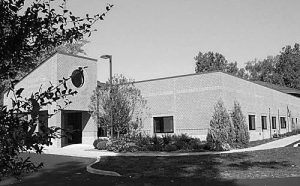
Sylvania Ave., Sylvania, Ohio
In January 2007, responding to the changing demographics of the Toledo area Jewish community, Rabbi Leff was instrumental in the synagogue’s move to a new smaller facility in Sylvania. Built in what has become the center of Jewish life on the JCC campus and adjacent to Temple Shomer Emunim, the synagogue reflects the continuing migration westward of Toledo Jewry to more outlying suburbs. The building marks a new departure for Toledo religious architecture. Designed in the round with the main bimah in the center of the sanctuary, it creates a warm and inviting atmosphere, while providing flexibility for a variety of services and activities. A dome surrounded by verses from Ch. 3 from Ecclesiastes beginning with the phrase ‘To everything there is a season, and a time to every purpose under Heaven …” covers the 200-300 seat sanctuary, a symbolic reflection of God’s protection of the Jewish people. As in the Kenwood building, the sanctuary can be expanded into the social hall for additional seating. There are two kosher kitchens, classrooms, a library, a community garden, a children’s room and a gift shop run by the Sisterhood. The sanctuary is handicap accessible and equipped with an induction loop system for the hearing impaired.
Rabbi Leff’s decision to make aliyah with his family in 2007 led to the appointment of Rabbi Moshe Saks. Among Rabbi Saks’ contributions were the reinvigoration of the daily minyan, leadership of SOAP (the Synagogue Organized Afternoon Program), and the expansion of the congregation’s involvement in community affairs.
Ivor Lichterman, who joined B’nai Israel as Hazzan (cantor) in 2011, assumed the role of spiritual leader soon after Rabbi Saks’ departure in 2013. Hazzan Lichterman has worked to maintain the daily minyan, involve lay men and women in daily and Shabbat services by introducing torah and Haftorah trop (chanting) classes, has expanded adult education programming, and has led trips of Jewish interest abroad, including biennial Confirmation Class Trips to Israel. Rabbi Jason Miller served as Visiting Rabbi from 2013 through 2017 and Rabbi Joan Friedman has been serving as Visiting Rabbi since 2018.
Congregation B’nai Israel looks forward to many more decades of dedicated service as the representative of Conservative Judaism in Toledo, Ohio.
May we go from strength to strength.
Previous resources written by Elaine Anderson, David Noel, Seymour Rothman and Rabbi Alan Sokobin were used in developing this historical update. The authors of this document, written in 2015 and updated in 2021, were Dr. David Weinberg, Cathy L. Sperling and Sharon G. Stein.
Congregation B'nai Israel
6525 Sylvania Avenue, Sylvania, Ohio 43560
419.517.8400|Email Us
